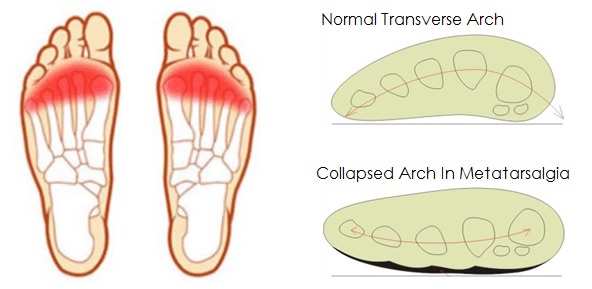Metatarsalgia is a general term for foot pain under the ball of the foot, the pads under the heads of the metatarsal bones.
Foot Anatomy
The five metatarsal bones extend from the mid-foot down to the toes, making a joint with the proximal (nearest) toe bones at the ball of the foot. These joints are called the metatarsophalangeal (MTP) joints.
The lateral (side to side) arch of the foot is maintained by these joints and the small postural muscles of the foot. A fatty pad underlies the joints to cushion the shocks of walking and running.
Who Gets Metatarsalgia?
Pain in the forefoot can occur to anyone but is most common in athletes in high impact sports and elderly people whose foot cushioning has reduced and who may have arthritic changes in the foot joints. Almost three times bodyweight may be transmitted through the forefoot during running.
Metatarsalgia Symptoms
- Pain under one or more of the metatarsal heads in the ball of the foot
- Foot pain worse when standing and pushing off in running or walking
- Gradual onset of the foot pain is most common
- A callus (hard skin) may form under the ball of the foot
- Sharp pain may be caused by compression of one of the small digital nerves, a condition often called Morton neuroma.
Metatarsalgia Treatment
- In the acute phase a physiotherapist will apply the PRICE principles. This involves reducing weight bearing, ice, compression bandage and elevation of the foot. Metatarsal pads and self-mobilisations of the nearby joints may be useful. Supportive shoes are not sufficient to give much relief from pain but more rigid orthotics may be helpful.
- As the foot pain reduces, range of movement and strengthening exercises can progress to weight bearing work.
- In the longer term an orthotic device (insole) may be necessary to move the forces on the foot away from their concentration over the heads of the metatarsal bones
- Modified shoes may be required in difficult cases
- Surgery to realign the forces through the metatarsal bones can be performed in severe cases.
References:
- Metatarsalgia – NHS Choices: http://www.nhs.uk/conditions/metatarsalgia/Pages/Introduction.aspx
Last Review Date: 08-01-2020
Next Review Date: 07-07-2021

